Spatiotemporal Evolution and Driving Factors of Ecosystem Supply and Demand Bundles: A Case Study in the Sichuan-Yunnan Ecological Buffer Area, China
Abstract
1. Introduction
2. Materials and Methods
2.1. Overview of the Study Area
2.2. Data Sources and Processing
2.3. Methodology
2.3.1. Research Framework
2.3.2. Estimation of the Supply of ESs
2.3.3. Estimation of Ecosystem Services (ES) Demand
2.3.4. Matching ES Supply and Demand
2.3.5. Identification of ES Bundles
2.3.6. Identification of Driving Factors
3. Results
3.1. Temporal ES Supply–Demand Patterns in the Ecological Buffer Area
3.1.1. Temporal Trends in Ecosystem Service (ES) Supply
3.1.2. Temporal Variations in Ecosystem Service (ES) Demand
3.1.3. Temporal Trends in the ESDR
3.2. Spatial Patterns in ES Supply and Demand
3.2.1. Spatial Trends in ES Supply
3.2.2. Spatial Trends in ES Demand
3.2.3. Spatial Dynamics of the ES Supply–Demand Ratio
3.3. ESBs
3.3.1. Results of Ecosystem Service Cluster Classification
3.3.2. Temporal Dynamics in ESBs
3.3.3. Spatial Dynamics in ES Supply Bundles
3.3.4. Spatial Dynamics in ES Demand Bundles
3.4. Factors Driving Ess in Functional Areas
4. Discussion
4.1. Validation of Ecosystem Service (ES) Assessment in the Ecological Buffer Area
4.2. Characteristics of ES Supply and Demand
4.3. Factors Affecting ESDBs
5. Conclusions
Author Contributions
Funding
Data Availability Statement
Conflicts of Interest
Correction Statement
References
- Costanza, R.; d’Arge, R.; De Groot, R.; Farber, S.; Grasso, M.; Hannon, B.; Limburg, K.; Naeem, S.; O’neill, R.V.; Paruelo, J.; et al. The value of the world’s ecosystem services and natural capital. Nature 1997, 387, 253–260. [Google Scholar] [CrossRef]
- Fu, B.; Tian, T.; Liu, Y.; Zhao, W. New developments and perspectives in physical geography in China. Chin. Geogr. Sci. 2019, 29, 363–371. [Google Scholar] [CrossRef]
- Daily, G.C.; Söderqvist, T.; Aniyar, S.; Arrow, K.; Dasgupta, P.; Ehrlich, P.R.; Folke, C.; Jansson, A.; Jansson, B.O.; Kautsky, N.; et al. Ecology—The value of nature and the nature of value. Science 2000, 289, 395–396. [Google Scholar] [CrossRef] [PubMed]
- Redhead, J.W.; May, L.; Oliver, T.H.; Hamel, P.; Sharp, R.; Bullock, J.M. National scale evaluation of the InVEST nutrient retention model in the United Kingdom. Sci. Total Environ. 2018, 610–611, 666–677. [Google Scholar] [CrossRef] [PubMed]
- Dade, M.C.; Mitchell, M.G.; McAlpine, C.A.; Rhodes, J.R. Assessing ecosystem service trade-offs and synergies: The need for a more mechanistic approach. Ambio 2019, 48, 1116–1128. [Google Scholar] [CrossRef] [PubMed]
- Mathieu, L.; Tinch, R.; Provins, A. Catchment management in England and Wales: The role of arguments for ecosystems and their services. Biodivers. Conserv. 2018, 27, 1639–1658. [Google Scholar]
- Yongxiu, S.; Shiliang, L.; Fangning, S.; Yi, A.; Mingqi, L.; Yixuan, L. Spatio-temporal variations and coupling of human activity intensity and ecosystem services based on the four-quadrant model on the Qinghai-Tibet Plateau. Sci. Total Environ. 2020, 743, 140721. [Google Scholar] [CrossRef] [PubMed]
- Guan, Q.; Hao, J.; Ren, G.; Li, M.; Chen, A.; Duan, W.; Chen, H. Ecological indexes for the analysis of the spatial-temporal characteristics of ecosystem service supply and demand: A case study of the major grain-producing regions in Quzhou, China. Ecol. Indic. 2020, 108, 105748. [Google Scholar] [CrossRef]
- Xu, M.; Feng, Q.; Zhang, S.; Lv, M.; Duan, B. Ecosystem services supply-demand matching and its driving factors: A case study of the Shanxi Section of the Yellow River Basin, China. Sustainability 2023, 15, 11016. [Google Scholar] [CrossRef]
- Bai, Y.; Wang, M.; Li, H.; Huang, S.F.; Alatalo, J.M. Theory and management methods of ecosystem service supply and demand. Acta Ecol. Sin. 2017, 37, 5846–5852. [Google Scholar]
- Tao, Q.; Tao, Y.; Ou, W. Analysis of the evolution of supply and demand for carbon sequestration services in the Yangtze River Delta region under different carbon emission reduction targets. Yangtze River Basin Resour. Environ. 2022, 31, 191–201. [Google Scholar]
- Baró, F.; Haase, D.; Gómez-Baggethun, E.; Frantzeskaki, N. Mismatches between ecosystem services supply and demand in urban areas: A quantitative assessment in five European cities. Ecol. Indic. 2015, 55, 146–158. [Google Scholar] [CrossRef]
- Burkhard, B.; Kroll, F.; Nedkov, S.; Müller, F. Mapping ecosystem service supply, demand, and budgets. Ecol. Indic. 2012, 21, 17–29. [Google Scholar] [CrossRef]
- Peng, J.; Yang, Y.; Xie, P.; Liu, Y. Green space ecological network construction zoning in Guangdong Province based on ecosystem service supply and demand. Acta Ecol. Sin. 2017, 37, 4562–4572. [Google Scholar]
- Bateman, I.J.; Harwood, A.R.; Mace, G.M.; Watson, R.T.; Abson, D.J.; Andrews, B.; Binner, A.; Crowe, A.; Day, B.H.; Dugdale, S.; et al. Bringing ecosystem services into economic decision making: Land use in the United Kingdom. Science 2013, 341, 45–50. [Google Scholar] [CrossRef]
- Dittrich, A.; Seppelt, R.; Václavík, T.; Cord, A.F. Integrating ESBs and socio-environmental conditions: A national scale analysis from Germany. Ecosyst. Serv. 2017, 28, 273–282. [Google Scholar] [CrossRef]
- Liu, C.F.; Wang, W.T.; Liu, L.C.; Li, P.J. Matching supply and demand of county ecosystem services in Northwest China—Take Gulang County, Gansu as an example. J. Nat. Resour. 2020, 35, 2177–2190. [Google Scholar]
- Zhang, P.; Liu, S.; Zhou, Z. Measurement and spatial and temporal evolution of ecosystem service supply and demand in the Beijing-Tianjin-Hebei region. Acta Ecol. Sin. 2021, 41, 3354–3367. [Google Scholar]
- Rong, Y.; Yan, Y.; Wang, C.; Zhang, W.; Zhu, J.; Lu, H.; Zheng, T. Construction and optimization of an ecological network in Xiongan New Area based on ecosystem service supply and demand. Acta Ecol. Sin. 2020, 40, 7197–7206. [Google Scholar]
- Lu, Y. Research on the Conduction Mechanism and Quantitative Simulation of Urban and Rural Ecosystem Service Flows. Master’s Thesis, Zhejiang University, Hangzhou, China, 2023. [Google Scholar]
- Wei, J.P.; Yang, Y.C.; Xin-Chang, X.; Liao, L.P.; Tian, Y.; Zhou, J.Y. Quantifying ecosystem service trade-offs and synergies in Nanning City based on ESBs. J. Ecol. Rural Environ. 2022, 38, 21–31. [Google Scholar]
- Zhao, H.; Li, C.; Gao, M. Investigation of the relationship between supply and demand of ecosystem services and the influencing factors in resource-based cities in China. Sustainability 2023, 15, 7397. [Google Scholar] [CrossRef]
- Gao, H.; Fu, T.; Zhu, J.; Wang, F.; Zhang, M.; Qi, F.; Liu, J. Supply and demand patterns investigations of water supply services based on ecosystem service flows in a mountainous area: Taihang Mountains case study. Sustainability 2023, 15, 13248. [Google Scholar] [CrossRef]
- Bennett, E.M.; Peterson, G.D.; Gordon, L.J. Understanding relationships among multiple ecosystem services. Ecol. Lett. 2009, 12, 1394–1404. [Google Scholar] [CrossRef] [PubMed]
- Raudsepp-Hearne, C.; Peterson, G.D.; Bennett, E.M. ESBs for analyzing trade-offs in diverse landscapes. Proc. Natl. Acad. Sci. USA 2010, 107, 5242–5247. [Google Scholar] [CrossRef] [PubMed]
- Wang, S.; Jin, T.; Yan, L. Ecosystem service trade-offs and coordinated changes and influencing factors in Ziwuling District. J. Appl. Ecol. 2022, 33, 1–13. [Google Scholar]
- Chen, T.; Feng, Z.; Zhao, H.; Wu, K. Identification of ESBs and driving factors in Beijing and its surrounding areas. Sci. Total Environ. 2020, 711, 134687. [Google Scholar] [CrossRef] [PubMed]
- Song, J.; Chen, S. Ecosystem service pattern of Fuzhou City based on ecosystem service clusters. J. Appl. Ecol. 2021, 32, 1045–1053. [Google Scholar]
- Wu, J.; Zhong, X.; Peng, J.; Qin, W. Small-scale regional ecological land functional classification based on ecosystem service clusters—Taking Chongqing Liangjiang New Area as an example. Acta Ecol. Sin. 2015, 35, 3808–3816. [Google Scholar]
- Gou, M.; Li, L.; Ouyang, S.; Wang, N.; La, L.; Liu, C.; Xiao, W. Identifying and analyzing ESBs and their socioecological drivers in the Three Gorges Reservoir Area. J. Clean. Prod. 2021, 307, 127208. [Google Scholar] [CrossRef]
- Xu, J.; Wang, S.; Xiao, Y.; Xie, G.; Wang, Y.; Zhang, C.; Li, P.; Lei, G. Mapping the spatiotemporal heterogeneity of ecosystem service relationships and bundles in Ningxia, China. J. Clean. Prod. 2021, 294, 126216. [Google Scholar] [CrossRef]
- Wang, R.; Pan, H.; Liu, Y. Spatial and temporal evolution of ecosystem service value and driving force in Leshan City based on the dynamic equivalent. J. Ecol. 2022, 42, 76–90. [Google Scholar]
- Zhao, M.; Peng, J.; Liu, Y.; Li, T.; Wang, Y. Mapping watershed-level ESBs in the Pearl River Delta, China. Ecol. Econ. 2018, 152, 106–117. [Google Scholar] [CrossRef]
- Huang, X.; Yang, Y.; Wu, Y.; Gao, Y.; Gu, Y.; Yuan, Z. Land use change and its impact on HQ in Karst Nature Reserve from 1990 to 2017. Bull. Soil Water Conserv. 2018, 38, 345–351. [Google Scholar]
- Wang, X.; Les, M.; Zhang, M. Changes in the ecosystem pattern of “two screens and three belts” and their influencing factors. J. Ecol. 2019, 38, 2138–2148. [Google Scholar]
- Xu, Q.; Li, L.; Li, G. Evaluating ecosystem services and their spatial relationship in the Yangtze River Basin. Chin. Geogr. Sci. 2020, 30, 681–691. [Google Scholar]
- Yin, L.; Wang, X.; Zhang, K. Trade-offs and Synergies of Land Utilization Services in National Barrier Areas. Geogr. Res. 2009, 38. [Google Scholar]
- Fu, B. Assessment of Land Use in National Ecological Barrier Zones; Science Publishing House: Beijing, China, 2017. [Google Scholar]
- Groten, S. NDVI-crop monitoring and early yield assessment of Burkina Faso. Remote Sens. 1993, 14, 1495–1515. [Google Scholar] [CrossRef]
- Zhang, R.; Guo, J.; Zhang, Y. Spatial distribution pattern of NPP of Xinjiang grassland and its response to climatic changes. Acta Ecol. Sin. 2020, 40, 5318–5326. [Google Scholar]
- Runting, R.K.; Bryan, B.A.; Dee, L.E.; Maseyk, F.J.F.; Mandle, L.; Hamel, P.; Wilson, K.A.; Yetka, K.; Possingham, H.P.; Rhodes, J.R. Incorporating climate change into ecosystem service assessments and decisions: A review. Glob. Change Biol. 2017, 23, 28–41. [Google Scholar] [CrossRef] [PubMed]
- Peng, J.; Hu, X.; Qiu, S.; Hu, Y.; Meersmans, J.; Liu, Y. Multifunctional landscape identification and associated development zoning in mountainous areas. Sci. Total Environ. 2019, 660, 765–775. [Google Scholar] [CrossRef]
- Field, C.B.; Randerson, J.T.; Malmström, C.M. Global net primary production: Combining ecology and remote sensing. Remote Sens. Environ. 1995, 51, 74–88. [Google Scholar] [CrossRef]
- Wang, B.S.; Chen, H.X.; Dong, Z.; Zhu, W.; Qiu, Q.Y.; Tang, L.N. Impact of land use change on the water conservation service of ecosystems in the urban agglomeration of the Golden Triangle of southern Fujian, China, in 2030. Acta Ecol. Sin. 2020, 40, 484–498. [Google Scholar]
- Zhang, L. Ecosystem Services Assessment and Its Driving Forces in the Bailongjiang Watershed of Gansu. Master’s Thesis, Lanzhou University, Lanzhou, China, 2016. [Google Scholar]
- Zeng, L. Study on Soil Erosion in Karst Area Based on RUSLE Model. Master’s Thesis, Peking University, Beijing, China, 2008. [Google Scholar]
- Bao, Y. Temporal and Spatial Change of Ecological Services on Loess Plateau of Shaanxi by InVEST Model. Master’s Thesis, Northwest University, Xi’an, China, 2015. [Google Scholar]
- Wang, B.; Zhao, J.; Hu, X. Analysis on trade-offs and synergistic relationships among multiple ecosystem services in the Shiyang river basin. Acta Ecol. Sin. 2018, 38, 7582–7595. [Google Scholar]
- Pan, J.H.; Zhang, Y.N. Spatiotemporal patterns of energy carbon footprint and decoupling effect in China. Acta Geogr. Sin. 2021, 76, 206–222. [Google Scholar]
- Shi, Y.; Shi, D.; Zhou, L.; Fang, R. Identification of ecosystem services supply and demand areas and simulation of ecosystem service flows in Shanghai. Ecol. Indic. 2020, 115, 1–14. [Google Scholar] [CrossRef]
- Chen, J.Y.; Wang, H.M.; Liu, G. Measurement and policy research on supply and demand of ecosystem services in Hangjiahu region from the perspective of “water-energy-grain”. Resour. Environ. Yangtze Basin 2019, 28, 542–553. [Google Scholar]
- Wang, B.-Y.; Wang, L.; Chen, J.-C.; Qi, Q.; He, S.-Y.; Yang, Z.-Q.; Li, Z.-H.; Li, K. Identification of ecological function zoning and its influencing factors in the Four Lakes Basin. J. Appl. Ecol. 2023, 34, 2757–2766. [Google Scholar] [CrossRef]
- Kohonen, T. Self-organized formation of topologically correct feature maps. Biol. Cybern. 1982, 43, 59–69. [Google Scholar] [CrossRef]
- Lin, J.; He, S.; Liu, X.; Huang, Z.; Li, M.; Chen, B.; Hu, W. Identifying conservation and restoration priorities for degraded coastal wetland vegetations: Integrating species distribution model and GeoDetector. Sci. Total Environ. 2024, 906, 167491. [Google Scholar] [CrossRef] [PubMed]
- Zhang, X.; Zheng, Z.; Sun, S.; Wen, Y.; Chen, H. Study on the driving factors of ecosystem service value under the dual influence of natural environment and human activities. J. Clean. Prod. 2023, 420, 138408. [Google Scholar] [CrossRef]
- Zhang, X.R.; Wang, X.; Cheng, C.; Liu, S.; Zhou, C. Study on the spatial flow of ecosystem services in the karst region of Southwest China based on supply and demand relationship. Acta Ecol. Sin. 2021, 41, 3368–3380. [Google Scholar]
- Wu, Y. Research on Landscape Pattern Optimization in Sichuan Province Based on the Balance of Supply and Demand of Ecosystem Services. Master’s Thesis, Sichuan University, Chengdu, China, 2021. [Google Scholar]
- Yin, Y.; Li, H.; Zhang, M. Spatial heterogeneity of ecosystem service trade-offs in different climate zones and its driving factors: A case study of the Sichuan-Yunnan-Loess Plateau ecological barrier zone. Acta Ecol. Sin. 2024, 44, 107–116. [Google Scholar]
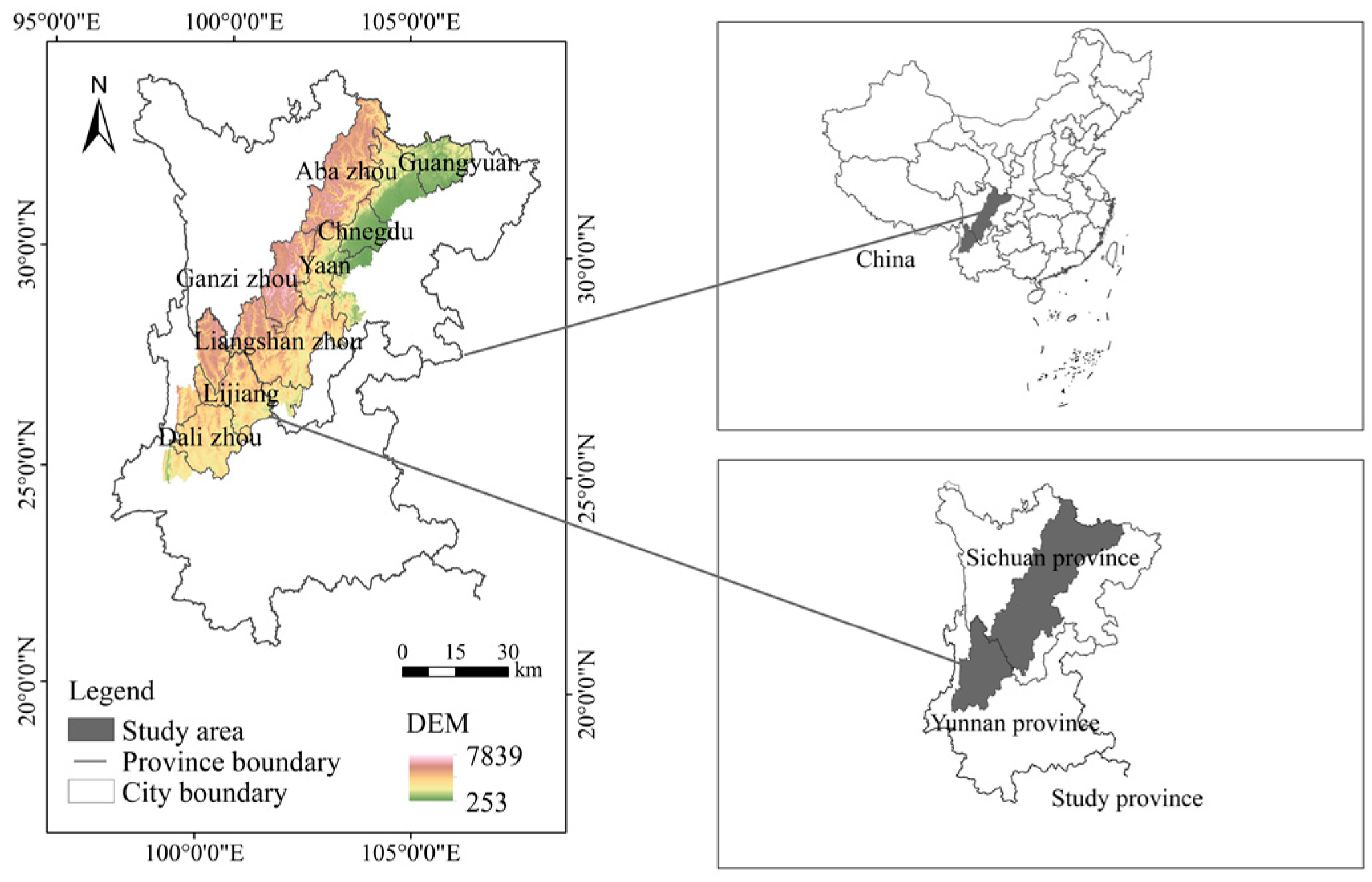
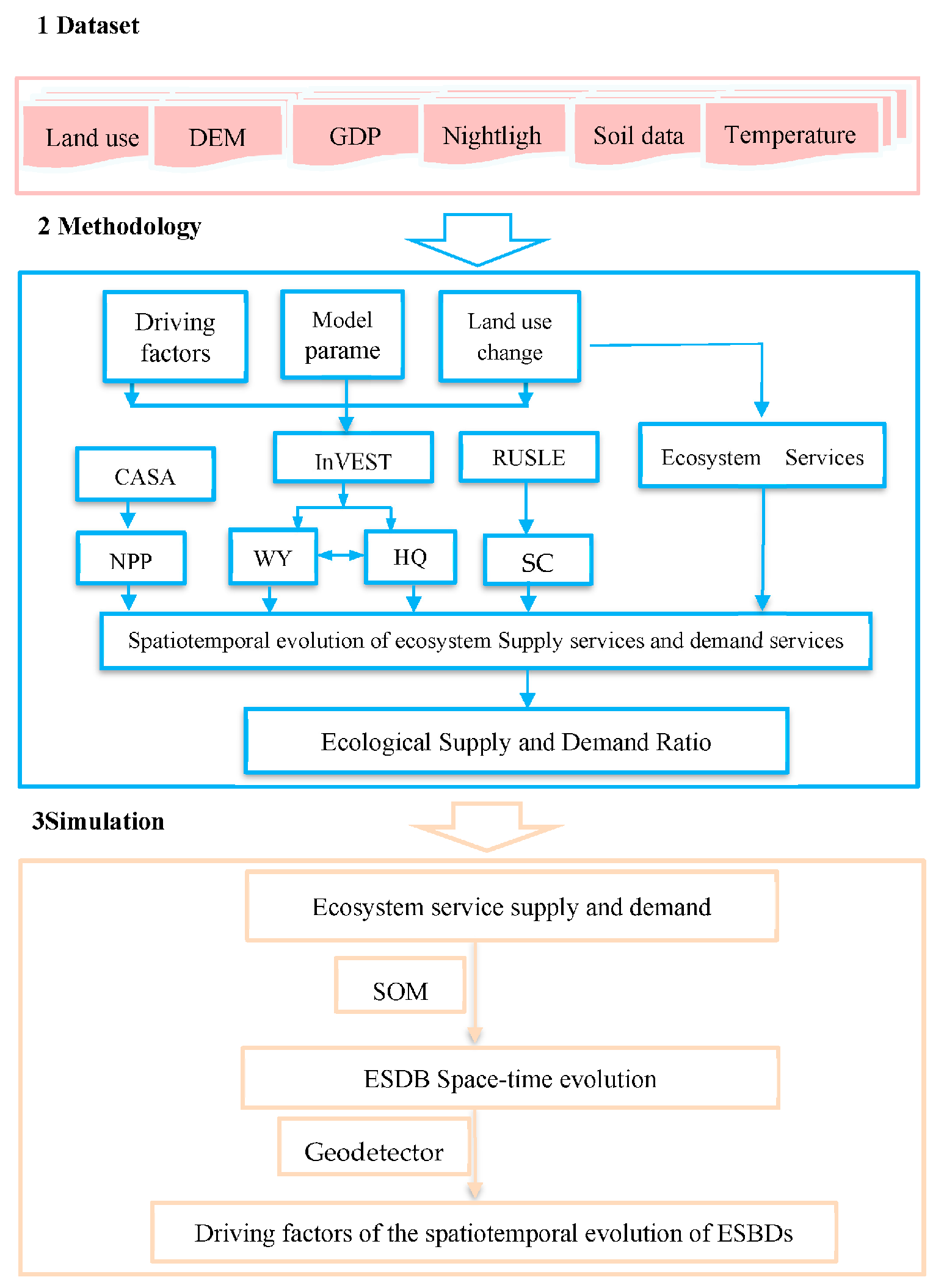
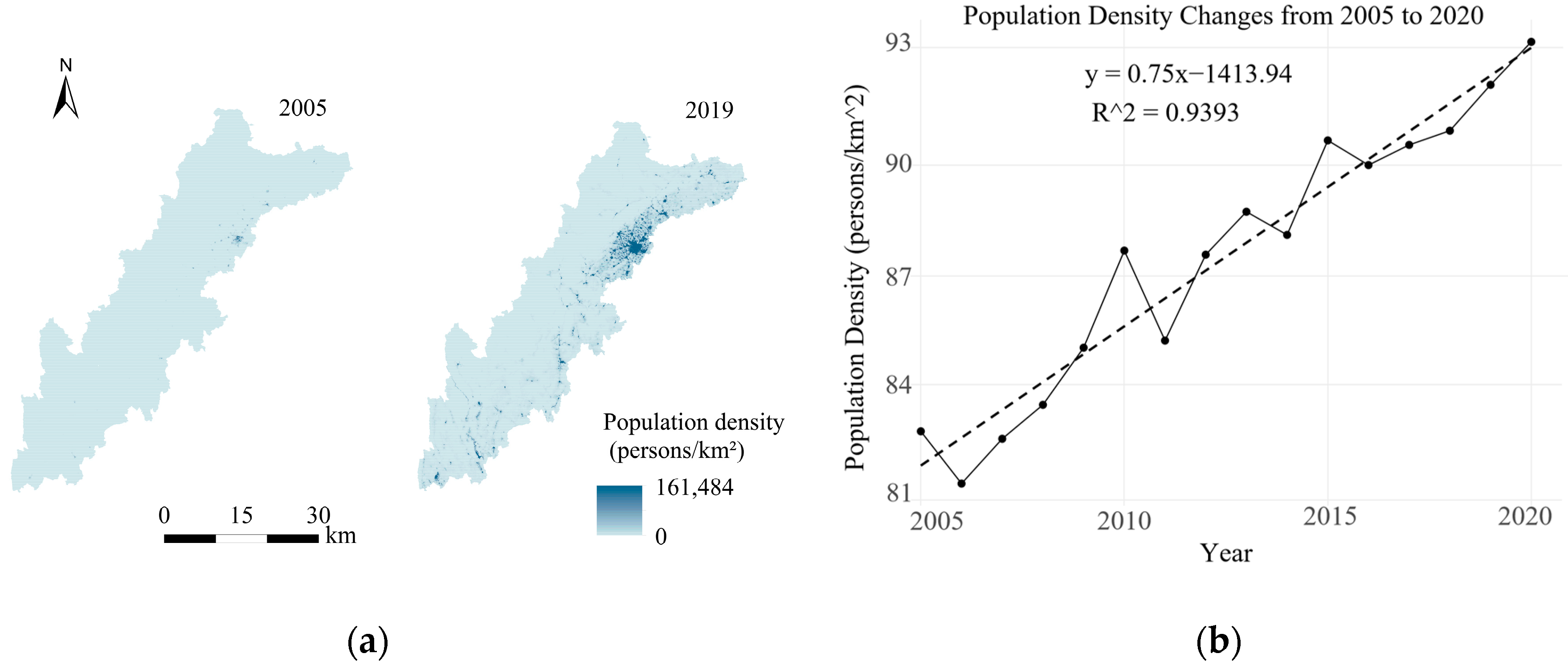
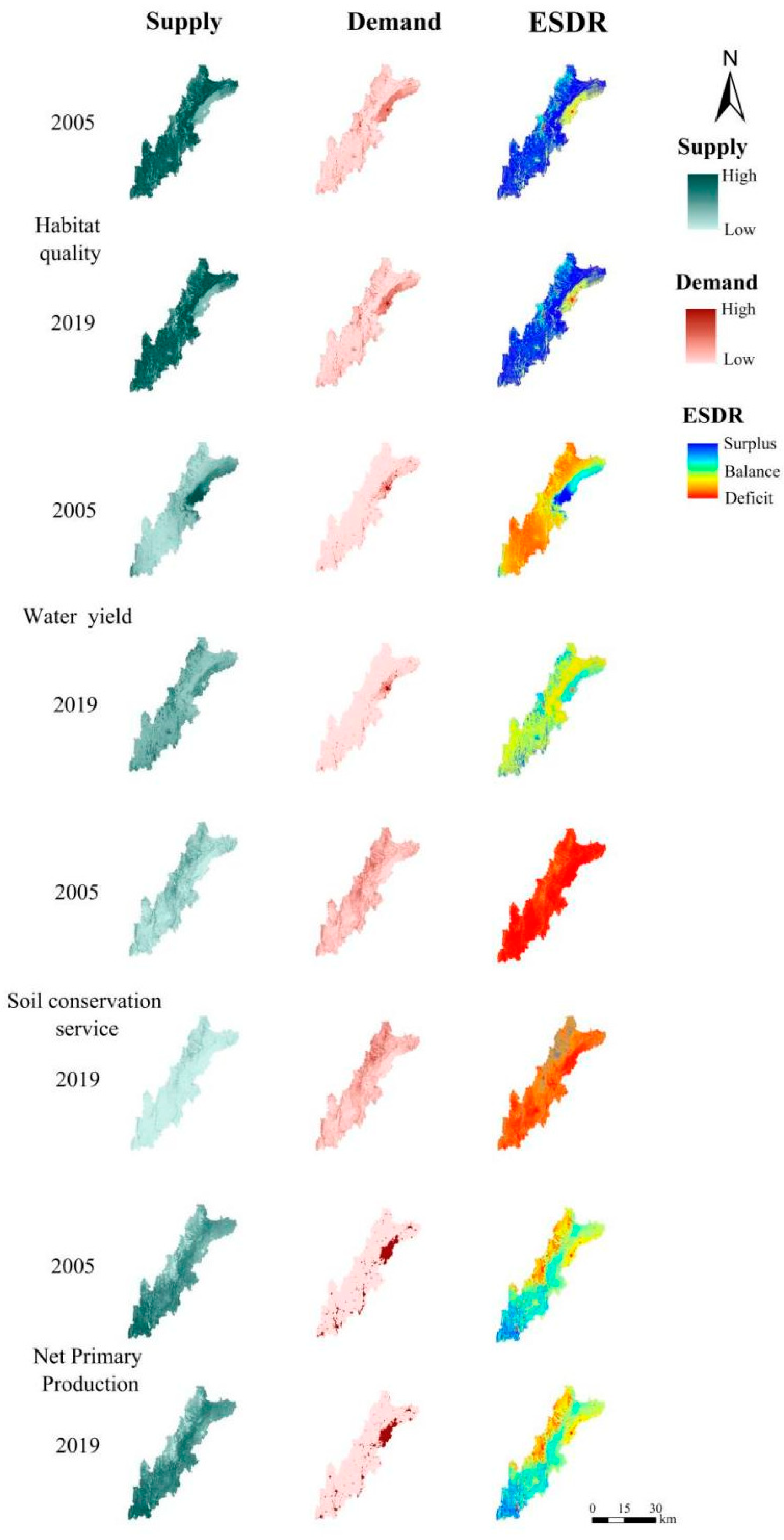
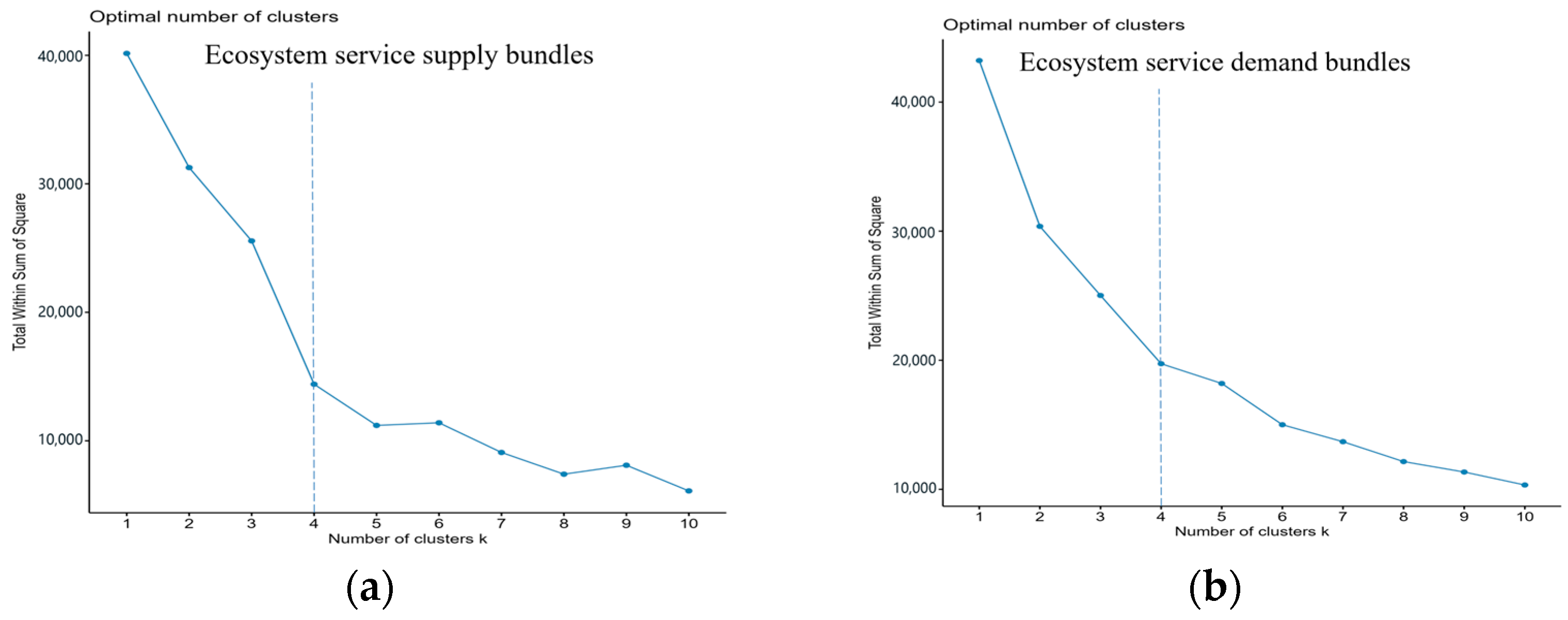
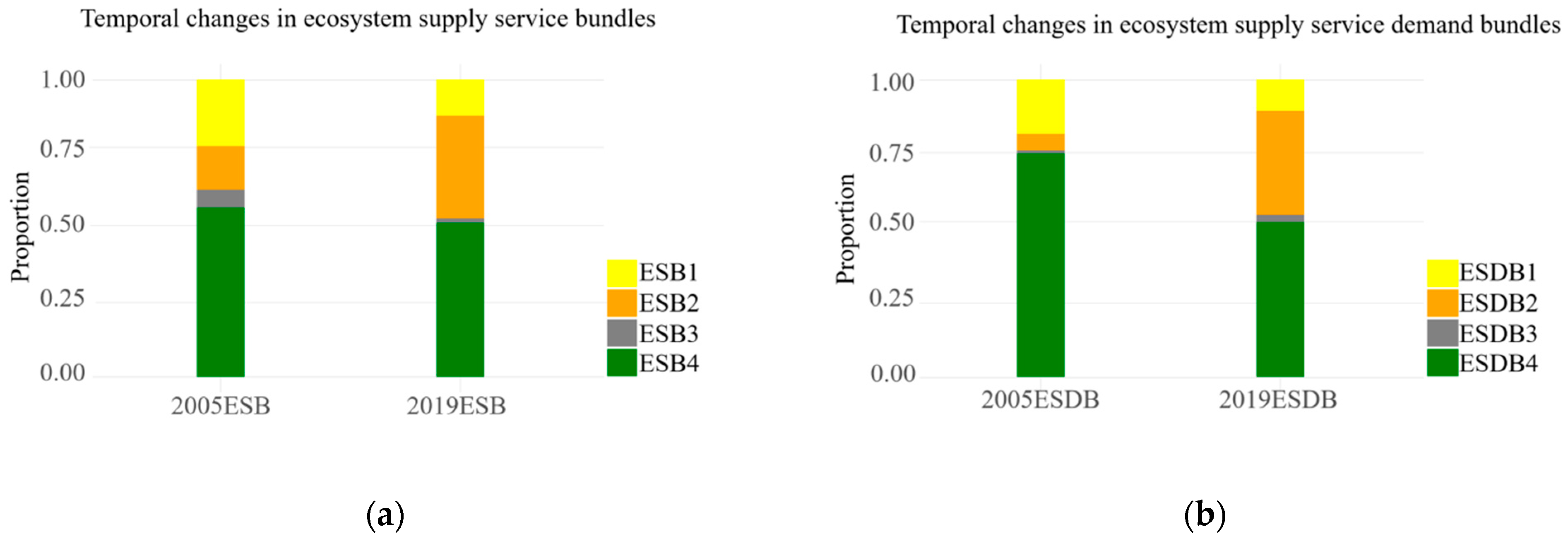
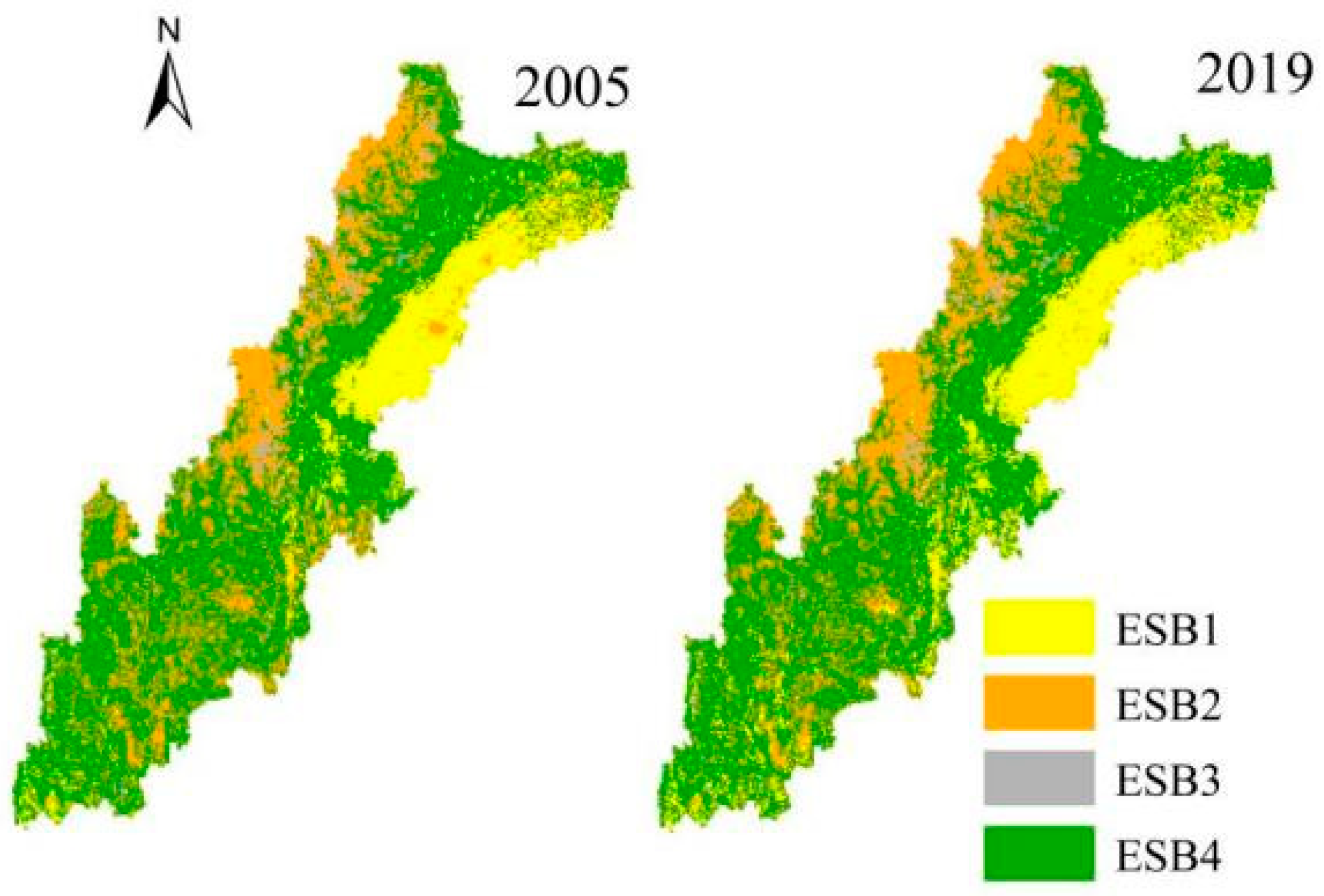
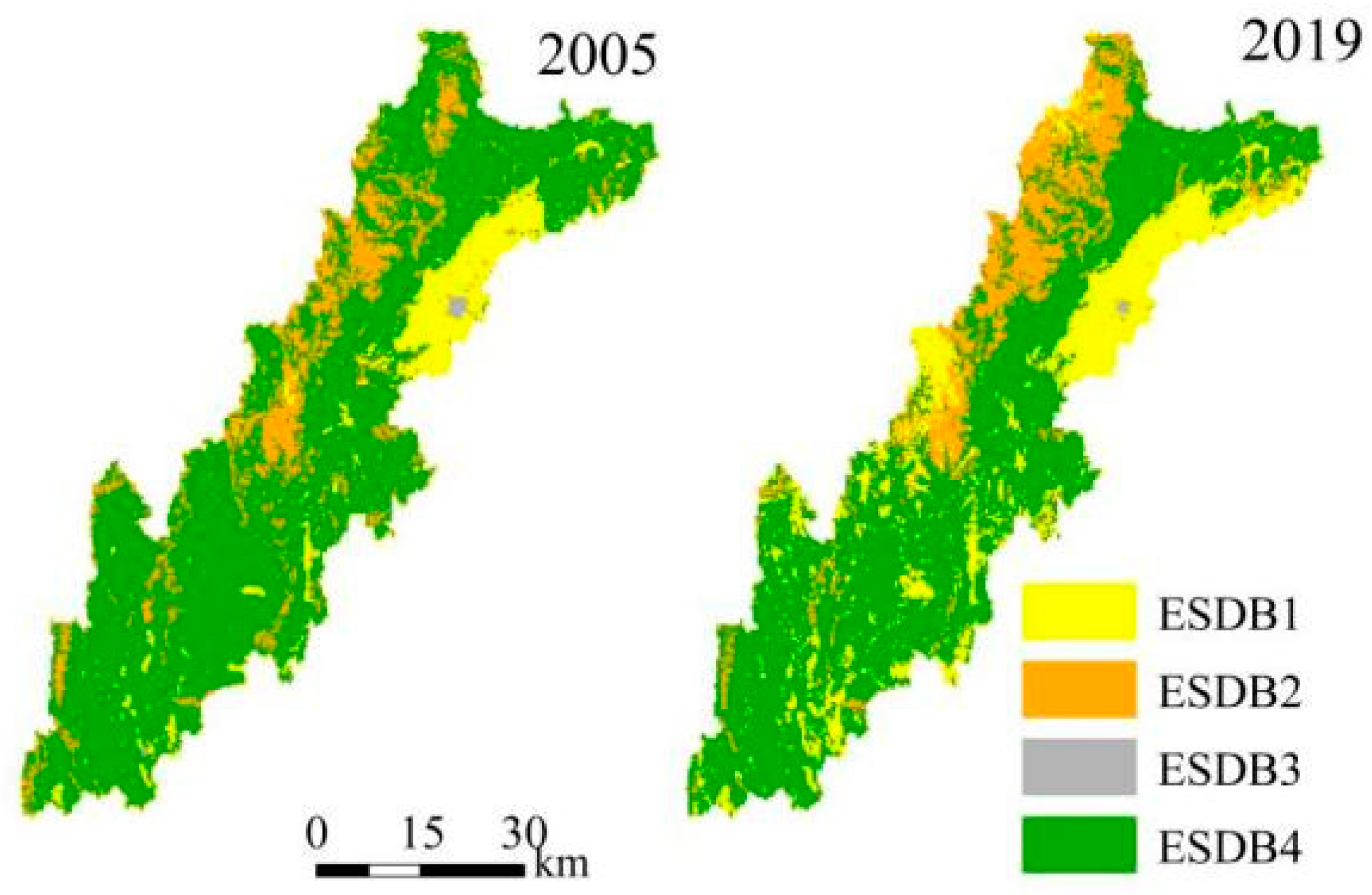

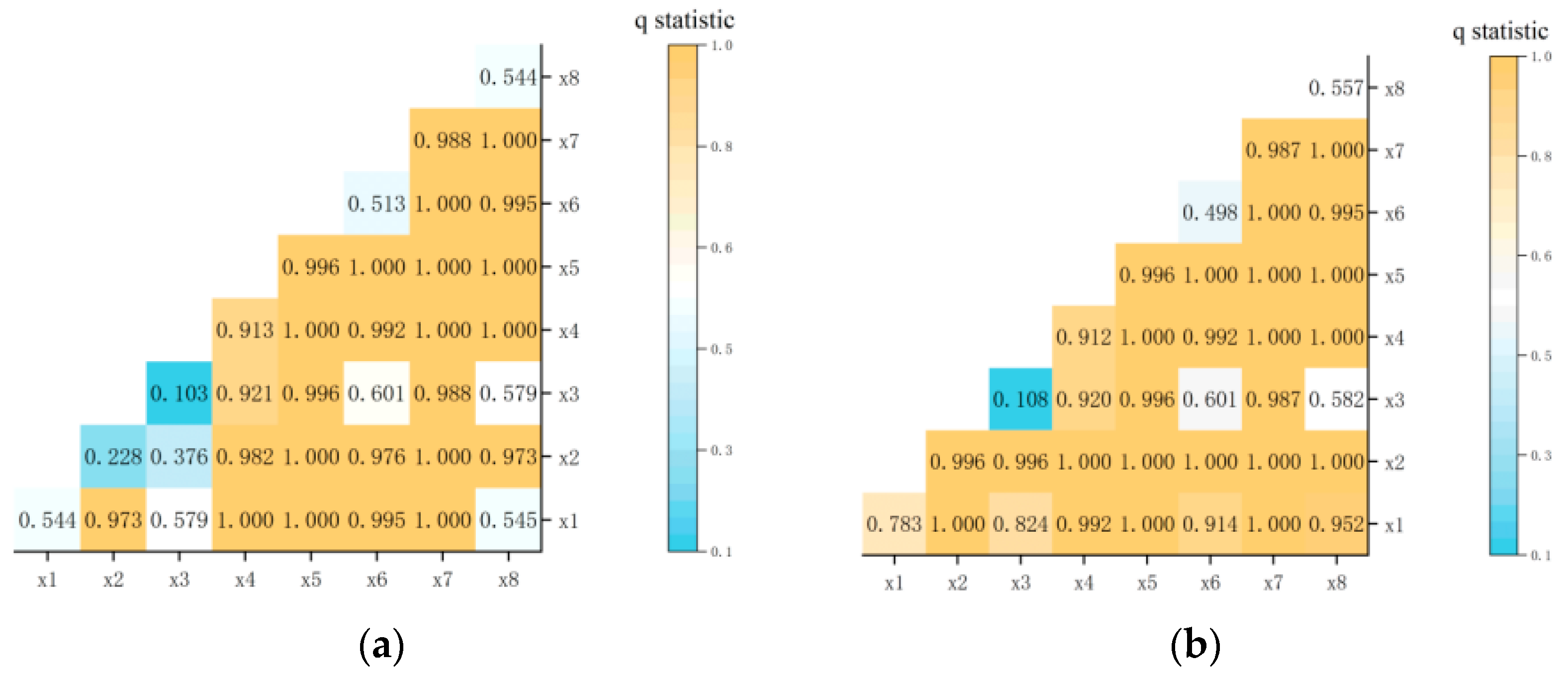
| Influencing Factors | Data Name | Data Format | Resolution | Data Source |
|---|---|---|---|---|
| X1 | NDVI | tif | 30 m | http://data.cma.cn/ |
| X2 | Land cover data | tif | 30 m | https://zenodo.org/ |
| X3 | Nightlight | tif | 1 km | http://data.tpdc.ac.cn/ |
| X4 | Population | tif | 1 km | https://www.worldpop.org/ |
| X5 | HAI | tif | 1 km | http://data.cma.cn/ |
| X6 | Annual precipitation | tif | 30 m | http://data.cma.cn/ |
| X7 | Average annual temperature data | tif | 30 m | http://data.cma.cn/ |
| X8 | Digital Elevation Model (DEM) | tif | 30 m | http://www.gscloud.cn/ |
| Type of Service | 2005 (Supply) | 2019 (Supply) | 2005 (Demand) | 2019 (Demand) | 2005 (ESDR) | 2019 (ESDR) |
|---|---|---|---|---|---|---|
| HQ | 0.847 | 0.816 | 0.398 | 0.405 | 0.821 | 0.808 |
| WY (mm) | 314.958 | 431.183 | 2620 | 2850 | 0.293 | 0.360 |
| SC (t/(hm2 a)) | 469.632 | 490.100 | 636 | 434 | 0.127 | 0.201 |
| NPP (gC/(m2 a)) | 687.173 | 707.841 | 2030 | 2920 | 0.692 | 0.693 |
Disclaimer/Publisher’s Note: The statements, opinions and data contained in all publications are solely those of the individual author(s) and contributor(s) and not of MDPI and/or the editor(s). MDPI and/or the editor(s) disclaim responsibility for any injury to people or property resulting from any ideas, methods, instructions or products referred to in the content. |
© 2024 by the authors. Licensee MDPI, Basel, Switzerland. This article is an open access article distributed under the terms and conditions of the Creative Commons Attribution (CC BY) license (https://creativecommons.org/licenses/by/4.0/).
Share and Cite
Yang, B.; Xue, D.; Miao, P. Spatiotemporal Evolution and Driving Factors of Ecosystem Supply and Demand Bundles: A Case Study in the Sichuan-Yunnan Ecological Buffer Area, China. Sustainability 2024, 16, 4977. https://doi.org/10.3390/su16124977
Yang B, Xue D, Miao P. Spatiotemporal Evolution and Driving Factors of Ecosystem Supply and Demand Bundles: A Case Study in the Sichuan-Yunnan Ecological Buffer Area, China. Sustainability. 2024; 16(12):4977. https://doi.org/10.3390/su16124977
Chicago/Turabian StyleYang, Bin, Dongqian Xue, and Peipei Miao. 2024. "Spatiotemporal Evolution and Driving Factors of Ecosystem Supply and Demand Bundles: A Case Study in the Sichuan-Yunnan Ecological Buffer Area, China" Sustainability 16, no. 12: 4977. https://doi.org/10.3390/su16124977
APA StyleYang, B., Xue, D., & Miao, P. (2024). Spatiotemporal Evolution and Driving Factors of Ecosystem Supply and Demand Bundles: A Case Study in the Sichuan-Yunnan Ecological Buffer Area, China. Sustainability, 16(12), 4977. https://doi.org/10.3390/su16124977







